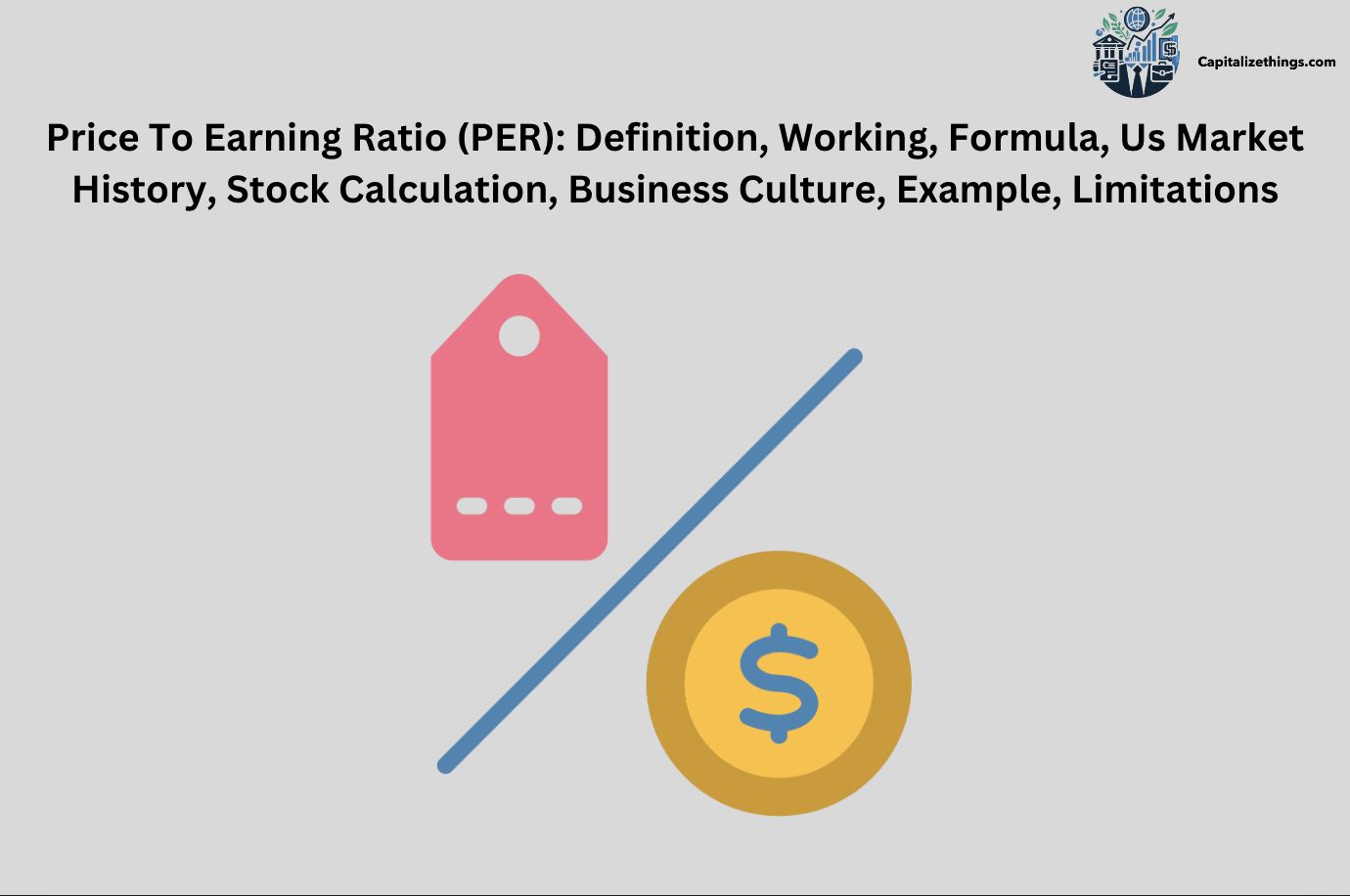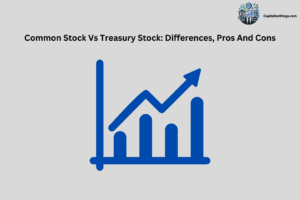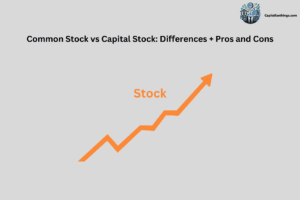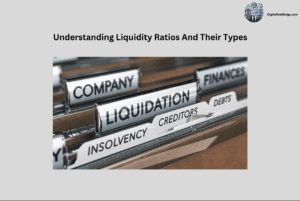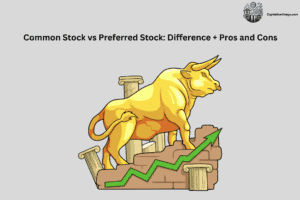The Price to Earnings Ratio (PER) is an economic metric that suggests how much traders are inclined to pay for every dollar of an employer’s earnings. It’s a key indicator used to evaluate the price of a corporation’s inventory relative to its profits. A better PER indicates that investors count on destiny increase, whilst a decreased PER also implies the inventory is undervalued or that the organization faces challenges. The PER works by evaluating the rate of a company’s stock to its earnings in step with percentage (EPS). Investors and analysts use this ratio to assess whether a stock is overrated, undervalued, or fairly valued. An excessive PER shows optimism approximately destiny profits, while a low PER suggests pessimism. The ratio facilitates traders to make knowledgeable selections through presenting a photograph of marketplace expectancies and agency overall performance.
The formulation for calculating the PER is straightforward:
PER = Market Value per Share / Earnings per Share (EPS)
For example, if an employer’s inventory is priced at $50 and its EPS is $five, the PER might be 10. This approach traders are inclined to pay $10 for every $1 of earnings.
In the U.S. Marketplace, the PER has grown appreciably through the years. During economic booms, the ratio frequently rises as investors anticipate higher destiny profits. Conversely, at some point of recessions, the PER tends to fall. The common historic PER for the S&P 500 is around 15-20, however it has spiked throughout bubbles, which includes the dot-com technology, and dropped at some point of crises like the 2008 monetary downturn. Stock calculation the use of the PER involves comparing a organization’s PER with the industry average or the broader marketplace. For instance, if an enterprise has a PER of 15 and the enterprise common is 20, the stock might be undervalued. Investors regularly use PER to decide whether a stock is priced primarily based on its earnings and the modern market situations.
Business culture extensively impacts the PER. In markets with excessive growth expectations, corporations can also have higher PERs due to investor optimism. Conversely, in markets with conservative business practices, PERs decrease. Cultural attitudes toward threat, increase, and innovation can affect how buyers perceive an enterprise’s destiny earnings potential, consequently impacting the PER.
Example of Price to Earnings Ratio (PER)
Consider an era employer with an inventory fee of $200 and an EPS of $10. The PER might be calculated as:
PER = 20
This way investors are inclined to pay $20 for every $1 of the enterprise’s profits. If the enterprise common PER is 25, this stock is probably taken into consideration undervalued. The PER has several barriers. It doesn’t account for destiny profits increase, that makes it deceptive for high-growth companies. Additionally, the PER can vary significantly across industries, making cross-sector comparisons difficult. Companies with irregular earnings or the ones in cyclical industries additionally have distorted PERs. Moreover, it doesn’t consider the corporation’s debt or cash float, limiting its effectiveness as a standalone metric.
Master the P/E Ratio for smarter investing. CapitalizeThings.com (+1 (323) 456-9123) clarifies its limitations and guides you towards well-rounded analysis. Get a free 15-minute consultation!
What is Price to Earning ratio (PER)?
The Price to Earnings Ratio (PER) measures a company’s inventory price relative to its profits in step with share (EPS). It shows how much buyers are willing to pay for each greenback of profits, reflecting marketplace expectations for future growth. The components is:
PER = Market Value per Share / Earnings per Share (EPS)
A higher PER shows higher predicted boom, whilst a decreased PER implies undervaluation or demanding situations facing the agency.
What Are The Common Other Short Names Of Price To Earning Ratio?
The Price to Earnings Ratio (PER) is often known by other brief names like P/E or P/E ratio. These phrases are utilized by equity studies analysts, investors, and private equity corporations. The ratio is vital in evaluating a stock’s marketplace capitalization. It compares the proportion charge to profits consistent with percentage (EPS) over an economic 12 months.
By the usage of the P/E ratio, traders assess if the inventory price is too excessive or low. This helps them decide if a stock is a superb buy or if it’s better to wait. The P/E ratio could be very important for anybody inquisitive about stocks.
What Are The Other Versions Of Price To Earning Ratio?
Two common versions of the price to earning ratio are the forward P/E and trailing P/E ratios. The forward P/E ratio uses destiny profits predictions. This enables investors to see what the PER might be based totally on expected growth. The trailing P/E ratio uses past income statistics, mainly from the closing monetary yr.
This shows how the stock performed before and after recessions. Another version consists of normalized EPS, which adjusts for irregular profits to provide a clearer photograph. Some buyers additionally use the geometric mean and mathematics imply of P/E ratios for contrast. These one-of-a-kind variations help traders make informed choices.
What Does A Per Interpret?
A Price to Earnings Ratio (PER) interprets how a good deal traders are willing to pay for every dollar of an employer’s profits according to percentage (EPS). If the PER is high, it suggests buyers expect future earnings to grow. Additionally suggests the stock is overvalued. If the PER is low, it could suggest the stock is undervalued or that traders count on decreasing destiny earnings.
This interpretation is important for expertise marketplace capitalization and stock valuation. It helps equity research analysts, and private equity firms check whether an inventory is a great investment. The PER also reflects a company’s retention policy and return on investment (ROI), making it a key indicator in monetary evaluation.
How Does A Price To Earning Ratio Work?
The Price to Earnings Ratio (PER) works by means of comparing a corporation’s stock rate to its income in line with proportion (EPS). This ratio suggests how many buyers are willing to pay for every dollar of income. A high PER way buyers expect a destiny boom.
A low PER shows the inventory can be undervalued. The PER is calculated using the marketplace capitalization and weighted common stocks terrific over a monetary 12 months. It allows equity studies analysts to compare an organization’s inventory rate in relation to its income. The PER also considers the agency’s return on investment (ROI) and future income capability. This makes it a crucial tool for stock valuation.
What Is The Formula For Price To Earning Ratio?
The formula for the Price to Earnings Ratio (PER) is:
PER = Market Value per Share / Earnings per Share (EPS)
It is calculated through dividing the market price according to share by the earnings per proportion (EPS). This ratio is critical for reading an inventory’s performance. It shows how a whole lot of buyers are willing to pay for each dollar of earnings. The formula makes use of key terms like marketplace capitalization, weighted average stocks extremely good, and normalized EPS. Equity studies analysts and personal equity firms rely upon these components to evaluate an organization’s stock valuation. It also facilitates in expertise a corporation’s go back on funding (ROI) and future earnings.
How To Calculate Pe Ratio Of A Company?
Calculating the Price to Earnings Ratio (PER) of an enterprise involves few steps. First, discover the marketplace value consistent with share, that’s the present-day stock fee. Next, decide the income according to proportion (EPS) from the employer’s monetary statements. The formulation is:
PER = Market Value per Share / Earnings per Share (EPS)
This calculation allows traders to examine if an inventory is overrated or undervalued. It uses key terms like market capitalization and weighted average stocks remarkably. The PER is a key tool for equity studies analysts. It facilitates them to determine a enterprise’s go back on funding (ROI) and destiny earnings capacity. This makes it crucial for inventory valuation.
What Are The Key Terms Of The Formula Of Company?
The key terms of the Price to Earnings Ratio (PER) system is market value per share and the earnings per share, these are vital for expertise on how the ratio works. Market price in step with proportion refers to the modern stock rate. Earnings in line with percentage (EPS) is the organization’s internet profits divided through the weighted common shares awesome. These terms are vital for calculating the PER.
Market capitalization, which is the overall fee of an agency’s stocks, additionally plays a function. Equity research analysts use those key phrases to assess an organization’s inventory. They assist in information about the corporation’s return on funding (ROI) and future earnings. These terms are critical for making informed funding decisions.
What Are The Most Commonly Used P/E Ratios?
The most typically used P/E ratios are the forward P/E and trailing P/E ratios. The ahead P/E ratio is calculated by the usage of predicted profits in line with share (EPS) for the subsequent monetary yr. This enables investors to examine a stock’s destiny earnings potential. The trailing P/E ratio uses the EPS from the past economic 12 months.
It gives an image of ways the stock has performed. Both ratios are important for know-how market capitalization and return on investment (ROI). Equity research analysts use those ratios to determine if a stock is overrated or undervalued. These ratios offer valuable insights for making investment decisions.
How To Calculate Price Earnings Ratio From Balance Sheet?
To calculate the Price to Earnings Ratio (PER) from a balance sheet, observe those steps. Start by discovering the corporation’s net income from the earnings assertion. Next, decide the weighted average shares awesome. Divide the net earnings by means of the weighted common shares to get the profits per proportion (EPS). Then, locate the marketplace value in line with the share, that’s the inventory price. The formulation is:
PER = Market Value per Share / Earnings per Share (EPS)
This calculation allows investigating if a stock is overvalued or undervalued. It uses key terms like market capitalization and return on investment (ROI). Equity studies analysts rely on this technique for accurate stock valuation.
Who Do You Valuate From P/E Ratio?
Price to Earnings Ratio (PER) valuation entails assessing whether an agency’s inventory is overestimated or undervalued. If the PER is higher than the enterprise average, the stock is probably overvalued. This suggests traders expect better destiny income. If the PER is decreased, the inventory can be undervalued, indicating decreased expectations. This valuation system allows equity research analysts to decide if a stock is a superb investment. It considers key elements like marketplace capitalization, earnings dilution, and go back on investment (ROI). The PER presents a clear photo of an organization’s economic fitness, assisting buyers make knowledgeable selections about buying or promoting shares.
What Is The Historical Per Of Us Stock Market For The S&P 500 Index?
The historic PER of the U.S. Stock market, particularly for the S&P 500 Index, has varied widely through the years. This ratio displays how plenty investors are willing to pay for every greenback of profits inside the marketplace. During periods of increase, the PER tends to upward thrust, whilst it falls throughout recessions.
The common PER for the S&P 500 over the past century is around 15-20. However, it has reached higher levels for the duration of marketplace bubbles and lower stages at some stage in crises. For example, throughout the dot-com bubble, the PER soared above forty, even as during the 2008 monetary crisis, it dropped under 10. The desk beneath suggests some extraordinary S&P 500 shares and their contemporary PERs:
| Stock | PER |
|---|---|
| Apple | 30.2 |
| Microsoft | 35.1 |
| Amazon | 60.5 |
| Alphabet (Google) | 25.4 |
| Tesla | 80.7 |
How Do You Calculate A Company Stock Using Price To Earning Ratio?
To calculate an agency’s stock cost the usage of the Price to Earnings Ratio (PER), you want to know the income in step with percentage (EPS). The EPS is found by dividing the enterprise’s internet profits via its weighted average shares splendidly. Then, multiply the EPS by the PER to estimate the inventory rate.
For example, if a business enterprise’s PER is 20 and its EPS is $5, the expected inventory fee might be $100. This technique enables investors to recognize if an inventory in all capitals is priced based totally on its profits. Equity studies analysts frequently use this method to cost stocks, in particular whilst evaluating corporations within the identical industry.
How Does A Price To Earning Ratio Help In Business Culture?
The P/E ratio serves as a crucial barometer in business culture, offering a concise gauge of a company’s perceived value and growth prospects relative to its earnings, thus informing strategic decisions and investor sentiment. In markets with excessive expectancies for future earnings, organizations frequently have high PERs. This indicates that buyers are positive about the enterprise’s growth. In more conservative enterprise cultures, wherein increase is steady and gradual, PERs usually decrease.
This reflects careful investor sentiment. In risky markets, PERs can fluctuate widely, indicating converting investor self-assurance. In conglomerates, the PER can be complex because of profits dilution throughout one-of-a-kind business segments. Understanding the PER helps traders gauge the market’s view of an employer’s capacity. It additionally influences how corporations’ technique their increase and retention regulations, aiming to meet or exceed market expectancies.
What Are An Investor’s Expectations From PE Ratio?
Investors use the P/E ratio to gauge how many tons they are inclined to pay for an organization’s income. A high P/E ratio suggests that buyers anticipate excessive destiny income increase. This way they agree that the employer will generate better returns on funding (ROI) through the years. Conversely, a low P/E ratio might also suggest that buyers have lower expectancies for future earnings. They see the stock is undervalued or consider the enterprise faces challenges.
Investors also don’t forget the P/E ratio relative to the marketplace or enterprise average. If an inventory’s P/E is higher than the common, investors anticipate it to outperform its friends. In precis, the P/E ratio allows investors to determine if an inventory aligns with their return expectancies.
How Is A Pe Ratio Expressed When Its Value Is Negative?
A negative P/E ratio is typically expressed as “N/A” or “undefined” to indicate that the conventional interpretation doesn’t apply due to negative earnings. Negative PE ratio typically happens when the business enterprise’s net earnings is inside the red for a monetary yr. A poor P/E ratio is mostly a red flag for buyers, indicating ability monetary hassle or a volatile enterprise version. Some buyers keep away from businesses with bad P/E ratios, whilst others might also see them as opportunities if they expect a turnaround. However, it’s important to apprehend why the agency’s earnings are terrible.
Is it due to temporary issues, or does it sign deeper troubles? The P/E ratio on my own cannot offer the entire photo, so buyers should also recall other elements like the company’s future profits potentialities, coins waft, and market function.
What Is An Example Of Price To Earning Ratio?
An example of a Price-to-Earnings (P/E) ratio is $20, which means investors are willing to pay $20 for every $1 of the company’s earnings.
Let’s take a better look at an another instance of the Price to Earnings Ratio (PER), suppose an enterprise’s inventory is buying and selling at $150, and it profits consistently with proportion is $10. This approach investors are inclined to pay $15 for each $1 of income. If the industry average PER is 20, this inventory might be taken into consideration undervalued. Investors also see it as a good buy if they trust the organization’s future earnings will develop. However, if the stock has a high PER compared to its friends, it might be overrated. This calculation helps traders decide whether to buy, sell, or preserve the inventory.
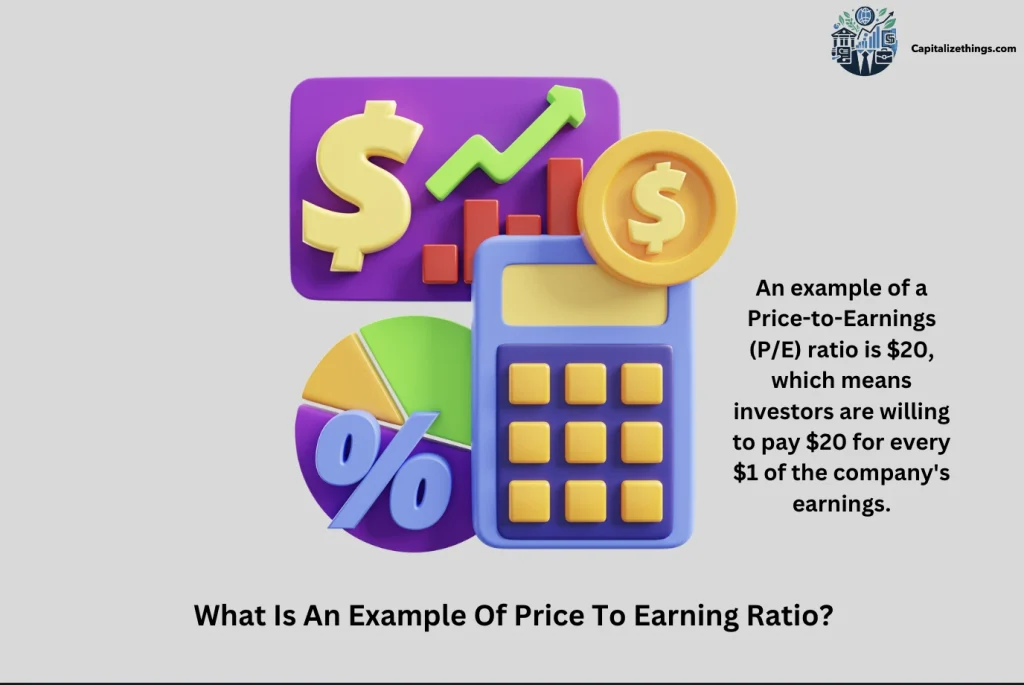
What Are The Limitations Of The Per?
The Price to Earnings Ratio (PER) has numerous limitations. First, it doesn’t account for destiny profits growth. Companies with excessive boom potential would possibly seem overvalued based on their modern PER. Second, the PER can range widely throughout industries, making it hard to compare corporations in distinctive sectors. For example, generation groups frequently have higher PERs than conventional industries like utilities.
Third, the PER doesn’t recollect an employer’s debt or cash float. A business enterprise with excessive debt has a low PER, however it could nevertheless be a volatile investment. Fourth and last one, the PER can be suffering from accounting practices, which includes earnings dilution from inventory alternatives or slush fund accounting, that could distort the genuine income.
What Is The Inverse Of P/E Ratio?
The inverse of the P/E ratio is the earnings yield. The earnings yield is calculated by dividing the income consistent with proportion (EPS) by means of the stock charge. It indicates how a good deal an organization earns for every greenback invested in its stock. If an inventory has a P/E ratio of 20, its profits yield could be five% (1/20). This metric is beneficial for evaluating the return on investment (ROI) of shares with exceptional P/E ratios.
It also facilitates traders to check the elegance of an inventory relative to different investment options, including bonds or non-public equity. Unlike the P/E ratio, which makes a speciality of rate, the income yield focuses on profits, presenting a specific perspective on price.
What Is Better Price To Earning Ratio Or Price/Earnings To Growth Ratio?
The Price to Earnings (P/E) Ratio and the Price/Earnings to Growth (PEG) Ratio are both important metrics for evaluating shares. The P/E ratio measures how many buyers are inclined to pay for each greenback of income. The PEG ratio, on the other hand, adjusts the P/E ratio via considering an agency’s earnings increase price.
A decreased PEG ratio shows that an inventory can be undervalued relative to its boom capacity. For agencies with excessive growth quotes, the PEG ratio gives a greater comprehensive view than the P/E ratio alone. In volatile markets, the PEG ratio can offer better insights right into a stock’s real value, because it considers each present-day earnings and future boom.
What Is The Difference Between Absolute Per And Relative Per?
Absolute PER and Relative PER are methods to assess a stock’s valuation. Absolute PER appears at the organization’s contemporary P/E ratio without comparing it to different stocks or benchmarks. It allows buyers to decide if a stock is hyped up or undervalued based totally on its own income. Relative PER, on the other hand, compares the P/E ratio to the market common, industry common, or a collection of friends. This approach affords context, supporting traders to see if an inventory is valued relative to others. While absolute PER offers a photograph of an organization’s valuation, relative PER offers a broader angle through placing it in the context of the market or industry.
What Is The Difference Between P/E Ratio And P/B Ratio?
The Price to Earnings (P/E) Ratio and Price to Book (P/B) Ratio are each tools for valuing shares, but they measure exclusive aspects. The P/E ratio compares an employer’s inventory rate to its earnings per proportion (EPS), specializing in profitability. It’s usually used to gauge how much buyers are willing to pay for destiny income. The P/B ratio, but compares the stock rate to the organization’s book cost, that’s its net asset price on the balance sheet.
This ratio is frequently used to evaluate whether an inventory is undervalued or overrated based totally on its actual property. While the P/E ratio emphasizes income, the P/B ratio highlights the enterprise’s financial stability and asset base.
What Is A Good Pe Ratio?
In general, a P/E ratio among 15 and 20 is taken into consideration correctly for most companies, but P/E ratio is always dependedent on the enterprise and marketplace conditions, This range indicates that the stock fee is truthful primarily based on its earnings in line with percentage. If the P/E ratio is simply too excessive, it can suggest the inventory is overpriced. If it’s miles too low, it can suggest the stock is undervalued. Investors use the P/E ratio to see if the stock is worth buying.
They compare it with the marketplace capitalization, net profits, and the enterprise’s return on funding (ROI). A suitable P/E ratio method has constant future income. However, the P/E ratio must be viewed with other financial metrics like the required charge of return and the business enterprise’s retention coverage.
Is High Price To Earning Ratio Better?
A high P/E ratio isn’t inherently better; it signifies higher investor expectations for future growth, but may also indicate overvaluation if not supported by strong fundamentals or growth prospects.. This approach is used by the organization to develop fast. A high P/E ratio is frequently seen in corporations with excessive market capitalization and growing internet income. It is desirable for shares in speedy-growing sectors, wherein destiny income is predicted to grow.
However, a high P/E ratio also can imply that the stock is overpriced and will fall if the enterprise does not meet income expectations. Investors should be cautious, mainly in unstable markets. They ought to examine different factors just like the organization’s return on investment (ROI) and the way it uses earnings dilution. An excessive P/E ratio isn’t always constantly higher, however it displays excessive increased capacity if used effectively.
Is Low Price To Earning Ratio Better?
A lower P/E ratio isn’t better or worse – it depends on context, whilst it indicates that an inventory is undervalued. Investors often search for low P/E ratios to discover deals. A low P/E ratio additionally implies that the market does not anticipate the organization to develop quickly. But it could additionally suggest that the inventory charge is low in comparison to its profits according to share.
This could provide an excellent shopping opportunity if the business enterprise’s destiny earnings enhance. A low P/E ratio is regularly observed in organizations with steady but gradual boom, low marketplace capitalization, and consistent go back on investment (ROI). However, a low P/E ratio can also imply that the company faces demanding situations, consisting of recessions or bad earnings dilution. Investors need to use a low P/E ratio with different monetary metrics to decide if the inventory is a great investment.
What Is The Negative Pe Ratio Value?
A negative P/E ratio value takes place when a business enterprise’s net profits is terrible. This way the company is losing cash and now does not have sufficient incomes to cowl its costs. A terrible P/E ratio is a red flag for buyers. It shows that the agency additionally faces critical financial problems. Companies with terrible P/E ratios are probably in trouble due to bad profits dilution, excessive charges, or a weak enterprise version. Investors should be careful with shares that have poor P/E ratios, as they will be very volatile.
Private equity traders from time to time study these stocks if they consider the corporation can recover. However, most investors keep away from businesses with bad P/E ratios, in particular if they don’t have any clean plan to improve their economic situation.
How Can Beginners Use P/E Ratios To Compare Different Investments?
Beginner investors can use P/E ratios to evaluate stocks via looking at how an awful lot buyers are willing to pay for each dollar of income. A decreased P/E ratio might imply an inventory is cheaper, at the same time as a higher P/E ratio could endorse that buyers expect strong future earnings. Beginners should compare the P/E ratios of groups within the equal enterprise to see which of them are better priced.
They must also remember the business enterprise’s marketplace capitalization, net income, and return on investment (ROI). Newbies can start by looking at shares with strong P/E ratios and constant profits consistent with percentage. It is crucial to bear in mind that the P/E ratio is simply one device, and it ought to be used with different financial records. This will assist beginners make higher selections whilst evaluating special investments.
How Does The P/E Ratio Help In Investment Appraisal?
The P/E ratio enables investment appraisal by showing how much buyers are procuring a business enterprise’s profits consistent with share. It is a quick manner to peer if an inventory in all equity is valued, overestimated, or undervalued. Investors use the P/E ratio to decide if a stock is well worth shopping for primarily based on its future earnings capacity. A low P/E ratio might endorse a good buying possibility, at the same time as a high P/E ratio could imply the inventory is costly. The P/E ratio is especially useful in evaluating shares within the same industry. It helps traders make selections based on the inventory charge, market capitalization, and expected return on funding (ROI). However, traders should additionally consider different elements, like the agency’s monetary 12 months overall performance and retention coverage.
What Does A High P/E Ratio Indicate About An Investment Opportunity?
An excessive P/E ratio frequently suggests that buyers assume strong future earnings from an organization. It suggests that traders are inclined to pay a premium for the inventory due to the fact they agree with it’ll develop. This is a high-quality sign if the organization is in a fast-developing enterprise with rising net profits and market capitalization.
An excessive P/E ratio implies that the inventory is priced for growth, but it also carries risks. If the enterprise does no longer meet earnings expectancies, the inventory fee should drop. Investors ought to be cautious with stocks that have excessive P/E ratios in risky markets. They should look at other elements, which include the business enterprise’s go back on funding (ROI) and income dilution, to decide if the investment possibility is really worth the danger.
Why Do Some Investment Companies In Us Focus On Low P/E Ratio Stocks?
Some investment agencies within the US are aware of low P/E ratio shares due to the fact they trust these stocks are undervalued. Low P/E ratio stocks additionally provide good shopping for opportunities if the agency’s destiny profits improve. These companies frequently search for shares with regular earnings in step with percentage, sturdy internet earnings, and solid marketplace capitalization. They agree that low P/E ratio stocks have less danger and extra room for fee boom.
This strategy is popular at some stage in recessions when many shares are priced low. Investment companies also like low P/E ratio shares due to the fact they can offer precise returns on funding (ROI) if the enterprise’s monetary scenario improves. However, focusing only on low P/E ratio shares can be unstable if the business enterprise faces ongoing challenges that save you profits.
How Does Industry Affect The Interpretation Of P/E Ratios For Investment Decisions?
Industry impacts the translation of P/E ratios due to the fact specific industries have special boom costs and marketplace expectations. For example, technology businesses often have high P/E ratios due to the fact they’re expected to grow rapidly, at the same time as application businesses would possibly have decreased P/E ratios because they’re extra stable. Investors must compare P/E ratios within the same industry to get a clearer photo of whether or not a stock is puffed up or undervalued.
An excessive P/E ratio in a single enterprise might be everyday however might be a warning sign up another. Understanding enterprise developments and the way they impact P/E ratios is important for making knowledgeable investment selections. Investors must also keep in mind different factors like market capitalization, internet earnings, and return on funding (ROI) when evaluating shares in unique industries.
How Does The Dividend Growth Rate Affect A Company’s P/E Ratio?
The dividend growth rate can affect a business enterprise’s P/E ratio with the aid of influencing investor expectancies. An agency that often will increase its dividends is frequently seen as stable and reliable, which could cause a higher P/E ratio. Investors can be inclined to pay extra for an inventory if they count on the employer to continue elevating its dividends. This is especially proper for corporations with sturdy marketplace capitalization and constant internet income.
On the other hand, if a corporation’s dividend increase charge slows down, its P/E ratio would possibly lower as traders emerge as much less confident in its destiny earnings. The dividend boom rate is vital in calculating an employer’s return on investment (ROI) and plays a key function in figuring out the inventory’s market value. Investors must not forget the dividend increase charge whilst assessing an organization’s P/E ratio.
What Role Do Financial Intermediaries Play In Influencing P/E Ratios?
Financial intermediaries, consisting of banks and agents, play a large function in influencing P/E ratios by means of affecting marketplace perceptions and inventory expenses. These intermediaries provide equity studies and evaluation that enables traders to decide whether to buy, hold, or sell shares. Their evaluations can substantially impact a company’s market capitalization and P/E ratio.
For instance, a tremendous record from an equity studies analyst can result in higher investor interest, which can drive up the stock fee and P/E ratio. Financial intermediaries also assist organizations to increase capital, which can affect their profits per share and overall economic health. By shaping investor sentiment and supplying market insights, economic intermediaries play a key role in determining P/E ratios and influencing funding selections.
How Can The Dividend Discount Model Be Used To Estimate A Fair P/E Ratio?
The Dividend Discount Model (DDM) can be used to estimate a fair P/E ratio by valuing a stock primarily based on its predicted destiny dividends. The DDM considers the employer’s dividend growth price, required rate of return, and retention coverage to calculate the stock’s honest cost. Investors can then evaluate this cost to the current market rate to decide if the P/E ratio is truthful. If the model shows that the inventory is undervalued, it might suggest a very good buying possibility.
The DDM is mainly useful for organizations with a strong record of paying dividends and stable marketplace capitalization. By estimating a truthful P/E ratio, the DDM allows buyers to make knowledgeable decisions about the inventory’s potential return on investment (ROI). However, the version works quality with businesses that have predictable dividend growth fees.
Conclude:
The Price to Earnings Ratio (P/E Ratio or PER) is a key tool in evaluating a corporation’s stock rate relative to its profits consistent with share. It helps investors gauge whether an inventory is puffed up, undervalued, or pretty priced. An excessive P/E ratio can suggest strong increase expectancies, at the same time as a low P/E ratio also propose an ability buying opportunity. However, the P/E ratio should no longer be used in isolation, because it does no longer account for elements like enterprise variations, dividend guidelines, or the company’s economic health.
Understanding a way to interpret the P/E ratio inside one-of-a-kind industries and marketplace conditions is essential for making knowledgeable funding choices. Financial intermediaries, like equity studies analysts, play an important role in shaping marketplace perceptions and influencing P/E ratios. Tools just like the Dividend Discount Model can further aid in estimating an honest P/E ratio by factoring in destiny dividends and required returns. For correct investment value determinations, the P/E ratio must be considered alongside different financial metrics and enterprise-precise tendencies.
Level up your stock analysis! CapitalizeThings.com goes beyond P/E to empower you with a comprehensive investment strategy. Reach us through email and our expert team would reach out back to you, or call us and lets discuss the future actions depending upon your situation.

Larry Frank is an accomplished financial analyst with over a decade of expertise in the finance sector. He holds a Master’s degree in Financial Economics from Johns Hopkins University and specializes in investment strategies, portfolio optimization, and market analytics. Renowned for his adept financial modeling and acute understanding of economic patterns, John provides invaluable insights to individual investors and corporations alike. His authoritative voice in financial publications underscores his status as a distinguished thought leader in the industry.

